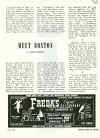
Click to enlarge.
Home Page Meet Boston Menu Index
|
MEET BOSTON Friday, July 24, 1942 in What's New In Town W. J. Sidis |
On the night of [Tuesday] April 18, 1775, another rider besides Paul Revere left Boston with the famous message for Middlesex (a message, incidentally, already received from other sources at Lexington.) William Dawes started out at the same time as Paul, and for the same destination. Having left his message at the Punch Bowl Inn, at Brookline Village, he rode on, lickety-split, up the road to Cambridge. A bend in a none too straight road, a bit of a brook, a farm grail leading to Sewall's Point—could he see that that desolate bit of country would some day be a great centre of people and trade? Probably not; but such was to be the case. With the building of the Mill Dam in 1821, that trail to Sewall's Point became an important road leading to the Dam and to Boston across the bay. The bend in the Harvard road became a crossroads, and rated a corner grocery store. And around Coolidge Brothers grocery a few houses arose—not many, for, even in Civil War days, this was way out in the country. In 1894, one of the old-time Boston grocery establishments, S. S. Pierce, bought out Coolidge's country store, and in what seemed a wild speculation, erected a fancy and elaborate branch store building on speculation, erected a fancy and elaborate branch store building on "Coolidge's Corner." It took over ten years to bring any sort of returns, but, as people moved into the Beacon Street part of Brookline, the Corner grew. By 1907, there were all of five stores in the vicinity—and people still coming in. New migrations in that direction made the vicinity still more important; new transportation improvements helped out, starting with the first subway opening in 1897, down to 1934, when the construction of Kenmore Station brought the subway to the Brookline line. (The old farm trail has advanced a long way). And "13 minutes to Park Street" is something. The former desolate spot has now become the most important neighborhood center in Brookline. "The stone which the builders rejected has become the headstone of the Corner."
*
Meridian Street in East Boston is built on a north-and-South line once supposed to be the line of the 71st meridian west of Greenwich, though actually missing the real meridian by about two miles. It is the only street in East Boston running due north and south all the way, and would be entitled to its name on that ground alone. The real 71st meridian comes very close to Suffolk Downs.
*
Anyone remember the old days when station names were painted in immense letters on the subway walls of the Tremont Street Subway and East Boston Tunnel—instead of the tiny black and white name-plates now use at these stations?